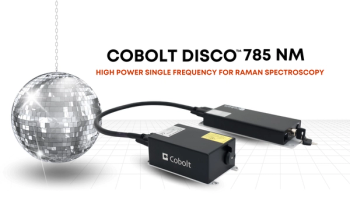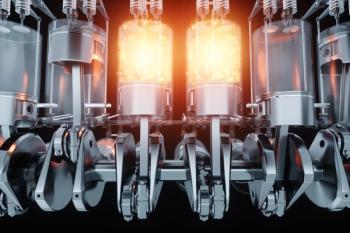
- Spectroscopy-10-01-2020
- Volume 35
- Issue 10
Lasers at the Intersection of Material Processing and Spectroscopy, Leading to Developments in Laser Ablation and LIBS
Advances in lasers are expanding the capabilities of LIBS and laser ablation techniques.
From the standpoint of technology and science in laser ablation and laser-induced breakdown spectroscopy (LIBS), large gains have been made in the past decade; our understanding has never been better. At the core, many of these advances in science have been enabled by developments in laser technology driven by the rapid growth of the market for lasers in industrial materials processing, welding, and manufacturing. The industrial lasers market is between $4 billion and $6 billion per year, depending on the definition, and growing at a compound annual growth rate of between 6 and 10%. The competition between types of lasers (such as CO2, fiber laser, and diode-pumped solid state) for particular applications has driven innovations in the lasers and dramatic reductions in cost. On the 60th anniversary of the invention of the laser, it seems appropriate to highlight these developments.
Highlights in Industrial Laser Development
One of the big news items in lasers over the past decade, as has been covered in previous installments of this column, has been the rise in fiber lasers. By pumping a gain medium into specialty fiber, a wide range of laser energies and pulse durations can be realized. Prices start below $10K USD. Moreover, fiber lasers have the most flexible deployment of all laser types, because they are already obviously fiber coupled. Hence, delivery from robotic platforms or relatively far from the laser source is easily possible.
SPI Lasers makes a range of industrial fiber lasers that spans from 20 W to 10 kW, with lower-energy versions having a range of pulsewidths from 3 ns up into the microsecond range, while the higher-energy versions have both continuous-wave and modulated modes of operation. Market leader Coherent focuses on the 1–10 kW range for its fiber lasers, providing widely adjustable beam qualities to optimize for various industrial processes, including laser welding, drilling, cutting, and surface treatment. Technology leader nLIGHT has optimized their CW fiber lasers for metal cutting and working, with variable beam shapes and powers available from 500 W to 15 kW, while IPG Photonics makes high-powered continuous-wave fiber lasers up to 100 kW, and has product over a broad spectral range from 512 nm to 2.05 micrometers.
NKT Photonics, Amplitude, and IPG Photonics are leaders in femtosecond fiber lasers for industrial applications. All three have lasers that cover the sub-500 fs range to approximately 20 ps, with a range of pulse energies and average powers up to 50 W.
Beyond femtosecond fiber lasers, solid-state femtosecond lasers have gotten much more rugged. For example, the Light Conversion Pharos systems provide between 190 fs and 20 ps pulses, at variable energies up to 2 mJ per pulse, repetition rates from 1 kHz to 1 MHz, and average power up to 20 W. Based on a Ytterbium gain medium, they have a fundamental wavelength of 1030 nm, and lasers are available including any of the harmonics to the 5th harmonic, 206 nm. These mechanically rugged packages are used in machining workstations.
Diode-pumped solid-state lasers have also come far in the past decade. Prices for laser diodes have fallen dramatically as demand for the reliability of diode-pumped over flashlamp-pumped Nd:YAG and other solid-state lasers has increased. These lasers have thus provided a cost-effective solution, with typically the highest wall-plug efficiency in a compact package. Along with excimer lasers, they are often used in semiconductor processing, where short wavelengths are key for producing small, diffraction-limited features.
Coherent and nLIGHT are examples of innovators in different domains of the diode laser space. While nLIGHT produces highly compact, high-brightness lasers up to 400 W in a handheld size, Coherent produces fiber-coupled diode systems largely in the higher-power range, between 1 and 10 kW. Several other manufacturers also compete in this space.
The other innovation in lasers for material processing has been the advent of sealed-cavity CO2 lasers. Traditional flowing-gas CO2 lasers are large installations, and have substantial ongoing costs for gases and maintenance. Sealed CO2 lasers became mature in the marketplace approximately a decade ago, and are valued for their high power, continuous output, compact size, and low cost. Leading producer Synrad has produced more than 250,000 sealed-cavity CO2 lasers.
The materials processing-related innovations in lasers have fed directly into the scientific arena, powering innovations in laser ablation and LIBS systems. In fact, prior knowledge about laser-material interactions allows proper laser selection in the industrial arena, and has spurred the developments noted above, in a virtuous cycle. Let’s investigate some of the developments that these lasers have allowed in the scientific arena.
Evolutions in Laser Ablation
Laser ablation creates aerosols that can be analyzed by inductively-coupled plasma–mass spectrometry (ICP-MS) or time-of-flight mass spectrometry (TOF-MS), among many downstream analysis methods. This method was pioneered on solid geological samples, but has been extended to many other types of samples. These laser ablation front ends are typically coupled to ICP-MS systems from manufacturers such as Agilent, Thermo Fisher, or Nu Instruments, or TOF-MS from TOFWerk.
The biggest advantages in laser ablation from new laser technologies have come from the dramatically increased reliability of femtosecond systems over the last decade, combined with lower cost, as well as the advent of long-lifetime excimer lasers that minimize halogen gas handling. Femtosecond lasers allow athermal removal of material, because the laser pulse duration is shorter than the typical phonon relaxation time, so no heat is transferred during the femtosecond laser pulse. The near-stoichiometric removal of material that results minimizes the need for inter-element corrections that are required for longer-pulse lasers. Excimer lasers and quintupled Nd:YAG lasers are favored because of their short (193 nm and 216 nm) wavelengths that are absorbed well in many “transparent” materials, allowing analysis of glass or particular minerals.
Through industry consolidation, several of the players in laser ablation have changed names in recent years. The biggest merger was the purchase of CETAC Technologies by Teledyne, followed by the subsequent purchase of Photon Machines, which is currently doing product development for Teledyne CETAC. This combination has yielded the greatest breadth of products available from any single manufacturer. Prior to the combination, CETAC offered ablation systems based on Nd:YAG platforms, while Photon Machines offered excimer and femtosecond laser-based platforms. Today, they offer 193 nm excimer-based systems, a 213 nm Nd:YAG system, and a femtosecond system. The femtosecond system is based on the aforementioned Pharos laser by Light Conversion. The system can provide more than 1.5 mJ (on-sample) per pulse, with spot sizes ranging from 1 to 65 µm at a fundamental wavelength of 1028 nm.
In addition, Teledyne CETAC also offers the Fusions CO2 and the Fusions Diode stepped heating systems. These devices provide highly controllable heating to solid samples, allowing measurements of evolved gases, such as for geochronology studies. The sealed-gas CO2 system operates at the fundamental 10.6 µm wavelength of the CO2 laser, while the diode laser-based system runs at 970 nm. Both depend on highly stable and rugged industrial lasers for long lifetimes.
Another change of hands happened when Elemental Scientific Inc. (ESI) purchased the laser ablation division of Electro Scientific Industries (also ESI) in 2017. This rather confusing non-change of initials brought back the New Wave Research brand that had been purchased by Electro Scientific Industries in 2007. For those interested, they also brought back the flashlamp-pumped research workhorse Tempest Nd:YAG laser. The newly formed subsidiary is called Elemental Scientific Lasers. Similar to Teledyne CETAC, they offer YAG, excimer, and a femtosecond laser ablation system based on the Pharos laser. Notably, they also offer a dedicated system for biological samples, optimized for low fluence, to prevent sample damage and fast washout times of the sample cell into the analyzer to optimize resolution.
A new application for laser ablation is the introduction by Zeiss of a laser ablation–based sample preparation step into its Crossbeam SEM. A diode-pumped solid-state laser/crystal fiber laser generates >350 fs pulses (10 µJ at 1 MHz) to burrow into a solid sample, exposing features at depth for detailed analysis by the scanning electron microscope. This novel combination is intended for rapid failure analysis in semiconductor manufacturing.
Offering products in both laser ablation and LIBS, Applied Spectra offers a new compact femtosecond system, as well as a combined laser ablation and LIBS system. This system has a compact sample chamber with a laser ablation sample cell, and can collect LIBS emission along with laser ablation solid sampling.
Evolutions in LIBS
The landscape of the product offerings in LIBS is changing with the changing mix of laser sources as well. While flashlamp-pumped Nd:YAG lasers still predominate in the research laboratory, as the best performers in terms of cost per laser power, more applied and industrial systems are using fit-for-purpose lasers.
Ocean Insight (formerly Ocean Optics) is building bespoke LIBS systems using both high-energy DPSS lasers and fiber lasers. The DPSS lasers are favored for their combination of high energy and long lifetimes, allowing them to create plasma on more refractory materials, such as minerals and soil, while remaining sealed and in-service for lengthy periods. The fiber lasers are used on materials that are easier to create plasma on, such as metals. These also have long lifetimes, and the high repetition rates are useful for in-process measurements. Elemission, Inc. was one of the first to use fiber lasers commercially, and has built systems for core analysis and slurry analysis. Among the first uses of fiber lasers for metals analysis were researchers led by Mohamad Sabsabi and François Doucet at the National Research Council (NRC) Canada.
Lightigo s.r.o, a startup in the Czech city of Brno, has introduced a new LIBS desktop called the Firefly, that has a motorized stage, gas handling, and a variety of spectrometer options, and uses a diode-pumped Nd:YAG laser at the fundamental, second, or fourth harmonic. Secopta of Berlin, Germany, has a desktop and industrial systems based on fiber lasers, as well as a DPSS-based industrial system. Another relatively new entrant, Leica Microsystems, has recently introduced the DM 6 LIBS, a confocal microscope for inspection that also incorporates a LIBS system for chemical contamination analysis and microstructure contamination analysis.
As with the laser ablation systems discussed above, many of these new LIBS systems just mentioned are reliant on DPSS and fiber lasers that until recently were not available with the features or at the price points that would have made them viable solutions for incorporating into scientific and industrial spectroscopy devices. A decade ago, nearly all of the lasers in LIBS systems, for example, were flashlamp-pumped Nd:YAG lasers, and laser ablation systems were just emerging with femtosecond lasers that at the time were still very high-maintenance and potentially unstable.
Conclusion
On the 60th anniversary of the laser, it seems fitting to note that what was a laboratory curiosity in 1960 is now very much a part of our industrial toolset, and that many of the tools that we take for granted in the laboratory rest on innovations in the laser that were spurred on by its wide adoption in industry. Truly, the laser has “crossed the chasm” from scientific innovation to the mainstream, and is now reaching back across that chasm to spur new science and new discoveries in a variety of fields of study.
Steven G. Buckley, PhD, is the Vice President of Product Development and Engineering at Ocean Insight, and an affiliate associate professor at the University of Washington, and has started and advised numerous companies in spectroscopy and in applications of machine learning. He has approximately 40 peer-reviewed publications and 6 patents. His work in practical optical spectroscopy, such as LIBS, Raman, and TDL spectroscopy, dovetails with the coverage in this column, which reviews methods (new and old) in laser-based spectroscopy and optical sensing. Direct correspondence to: SpectroscopyEdit@mmhgroup.com.
Articles in this issue
Newsletter
Get essential updates on the latest spectroscopy technologies, regulatory standards, and best practices—subscribe today to Spectroscopy.




